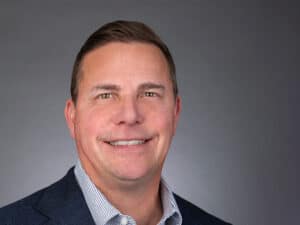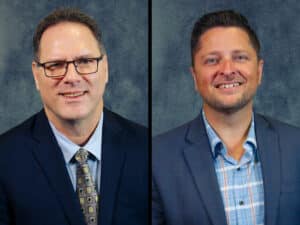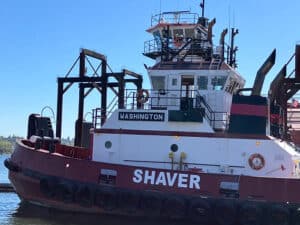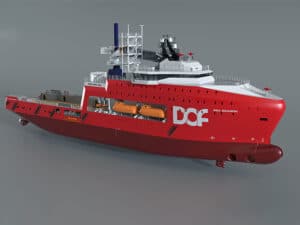
Q&A: Rick Spaulding on being president of SNAME
Written by Heather Ervin
Rick Spaulding
Rick Spaulding, a retired shipbuilder with over 39 years of ship design, planning and construction experience, recently talked to Marine Log on his maritime career and his new role as president of the Society of Naval Architects and Marine Engineers (SNAME).
Prior to his retirement, he was vice president of Business Process Standardization for Newport News Shipbuilding, a division of Huntington Ingalls Industries. Named to this position in 2019, Spaulding was responsible for the standardization and implementation of program and production standards across the company, acceleration of digital shipbuilding, Industrial Engineering, and other key business functions. During his tenure at Newport News Shipbuilding, Rick led efforts to share best practices across all HII business units.
Here’s more on Spaulding and his plans with SNAME.
Marine Log (ML): First, how did you become involved with SNAME?
RS: My first professor in the Naval Architecture and Marine Engineering Department at the University of Michigan was Harry Benford. During our first class of the semester, Professor Benford talked to us about the importance and benefits of being members of an engineering association during college and our professional careers. Being students of naval architecture, he highly recommended that we consider joining SNAME, and advised us that there is a student section at Michigan called the Quarterdeck Society. My Grandfather, was also an engineer and gave me the same advice. So, I borrowed a few dollars from my parents and signed up. That was in 1981, I have been a member for 43 years!
After graduating from college, I went to work at Newport News Ship Building. Not long after I started work, our department Director Mr. Roy Harrington stopped by my office and asked me why I wasn’t at the SNAME Hampton Roads Section meeting the previous evening. Being a new kid on the block, I wasn’t quite sure how to respond other than, “well I didn’t know there was a meeting.”
Harrington made it quite clear to me that I was to join the local section of SNAME, attend each of the meetings and that I should volunteer to serve on committees including the executive committee, eventually earning the position of chair, which I did. While I didn’t appreciate being told to do this, I’m really glad I did. As a member and ultimately a leader of a local section, I was able to practice skills in leadership, making presentations, and setting plans for future meetings and presentations. It also gave me the opportunity to network with other leaders in my company as well as people from other companies in the Hampton Roads area. This experience helped build my leadership tool kit and was a foundation for my career.
ML: As an independent marine technical society, what’s your vision and how do you plan to achieve that vision?
RS: SNAME is 131 years old. It has been in existence for all these years because our membership continues to find value in our symposia, webinars, support of professional licensure and continuing education programs, technical research and textbooks, and opportunities to network with peers across the industry. My vision for SNAME is that we maintain and increase our position in the maritime industry as the go-to association for relevant and valuable information, training, and technologies for all maritime processes including ship design, construction, repair, forensics, supply chain, and offshore design and operations including minerals, energy, and transportation. We are doing this by growing our relationships with industry, universities, and our membership as we seek their input on industry knowledge gaps and develop solutions to close these gaps. Through these relationships, we believe that we will grow membership and continue to hold a leadership position in industry for years to come.
As an example, leadership of each of our 20 Sections are charged with engaging with their members, industry, and universities to understand their needs. This is because they are embedded in the maritime communities around the world and have greatest access to the drum beat of industry and education. I have been traveling to many of our SNAME sections and have also attended conferences around the world to discuss the benefits of SNAME membership but more importantly to listen to the needs of industry and our membership. I believe that communication is key and together with the SNAME HQ staff we are updating our communications to keep people informed of what we are doing and listen to their needs.
ML: SNAME represents over 4,000 members. Can you give us an overview of your member demographics and how they benefit from joining SNAME?
RS: About 70% of our members are “Professional” members; members who are working in the maritime industry. Our members reside or work in countries around the world and belong to one of 20 local SNAME Sections. About 40% of our members live or work outside of the United States. Student members make up another 23% of our membership. Student members are those who are attending a college, university, or other educational program and are interested in being a member of SNAME. SNAME has over 40 student sections from 11 countries across three continents. Also, about 7% of our members are “SNAME Fellows.”
The grade of Fellow is given to those members who have demonstrated outstanding personal contributions to the profession of naval architecture, marine engineering, ocean engineering, or allied disciplines through significant achievements in design, research, production, operations, education, or leadership. Fellows are nominated by their colleagues and peers and then selected based on their accomplishments. SNAME has nearly equal numbers of very experienced and highly skilled members who are leaders in industry and are well poised to help mentor and train a nearly equal percentage of student and young professional members who are entering or new to the profession and are eager to learn.
ML: What about new or prospective naval architects and marine engineers? Do you offer anything to this group in terms of education or further education?
RS: Well first of all I’d like to clarify that SNAME membership is for anyone interested in a maritime profession, not just naval architects. We understand that tough maritime problems require individuals with a wide array of education and experience, not just Naval Architects and Marine Engineers. Earlier in our interview, I mentioned that SNAME has over 40 student sections at universities and technical colleges around the world. These sections provide a forum for students to reach out to industry for mentorship and support during and following their education and also provide members access to the faculty advisors to discuss industry needs.
Following graduation, SNAME encourages young professionals and professional members to achieve professional licensure and continuous education through SNAME’s PE preparation course, examinations, and continuing education webinars and symposia technical presentations, and Section presentations. SNAME is also a member society of ABET; SNAME members develop accreditation criteria and its Program Evaluators perform the accreditation reviews for maritime education programs at colleges, universities, and academies across the United States and internationally.
ML: SNAME is also involved in research and development. Can you tell us more about this?
RS: SNAME has a Technology and Research program consisting of 10 Committees each with panels that focus on specialized technologies from hydrodynamics, hull structures, and ships machinery, through operations and safety, offshore, environmental engineering, ship and small craft design, production, and marine forensics. These committees and their 70 panels consist of volunteers, with a wide range of knowledge and experience, who work together to develop new and emerging technologies, as well as develop formal guidance documents and bulletins which describe engineering methods. design procedures, and best practices for their area of focus.
Further, SNAME often works with members of industry to help solve specific maritime challenges. These projects are termed “Joint Industry Projects, or JIP’s” and are led/facilitated by SNAME and supported by representatives of the industry. For example, SNAME recently completed a JIP with the offshore wind industry to develop site-specific assessment guidance for the installation of fixed offshore wind platforms and is currently working with the offshore minerals industry to develop guidelines for the safe transfer and transportation of nodules mined from the seabed from the dredging vessel to the delivery vessels. We welcome anyone who has an interest in working with us on maritime technologies or research to join SNAME and become a leader or member of one of our Technology and Research committees.




